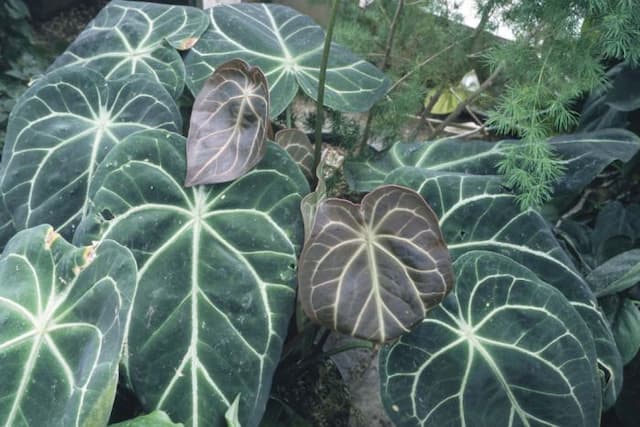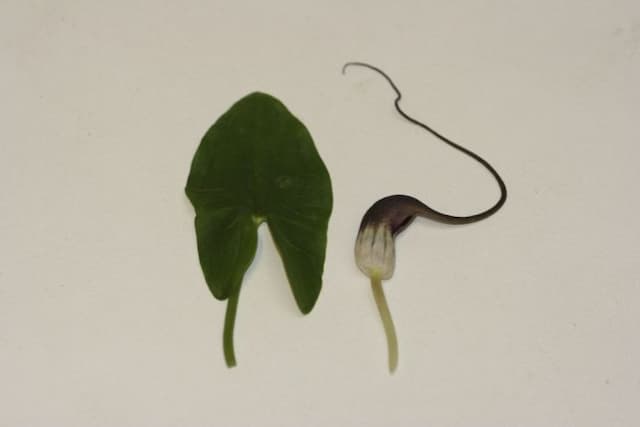Taro Colocasia esculenta



ABOUT
Taro, Colocasia esculenta, is a herbaceous tuberous evergreen perennial with long-stemmed, heart-shaped or arrow-shaped, soft velvety, deep green leaves.
The root system forms a large underground tuber 2.5 to 3 inches in diameter, which can reach a weight of up to 9 pounds. Tuber flesh may be white or cream, yellow, orange, pink or red in different varieties.
The leaves are large, heart-shaped or arrow-shaped, up to 3 feet long and up to 2 feet wide, forming a root rosette, on long, grooved petioles at the base up to 6.5 feet long.
It is a tropical plant grown primarily as a vegetable. It can also be grown as an ornamental plant because of its huge, showy foliage, adding a little bit of the tropics to your interior or garden.
The flowers resemble calla flowers, consisting of a yellowish-green calyx and spadix.
About this plant
 Names
NamesFamily
Araceae
Synonyms
Taro, Elephant ears, Aivi, Bleeding Heart, Egyptian ginger, Imo, Callaloo, Keladi, Cocoyam, Dalo, Dasheen, Eddo, Kalo, Arabian cocoa root, Egyptian cocoa root
Common names
Alocasia formosana, Arum colocasia, Arum esculentum, Arum peltatum, Caladium esculentum, Colocasia antiquorum, Colocasia antiquorum var. esculenta, Colocasia antiquorum var. euchlora, Colodium esculentum, Colodium colocasia, Colocasia formosana
 Toxicity
ToxicityTo humans
Poisonous until cooked.
All parts of the plant are toxic if eaten uncooked, and may cause skin irritation. If it comes into contact with the mouth, it stings.To pets
According to the ASPCA, the plant is toxic to cats, dogs and horses because of insoluble calcium oxalates.
Symptoms of poisoning in animals include oral irritation, pain and swelling of the mouth, tongue and lips, copious salivation, vomiting (except in horses), and difficulty swallowing.
 Characteristics
CharacteristicsLife cycle
Perennials
Foliage type
Evergreen
Color of leaves
Green
Flower color
White
Height
3 feet
Spread
2 feet
Plant type
Herb
Hardiness zones
7
Native area
Africa, Asia
Benefits
 General Benefits
General BenefitsIn areas of natural disadvantage, this plant is used as a food.
People usually eat its edible rhizome and leaves. It is usually stewed, fried, or boiled. It is also used in baking.
The leaves are rich in vitamins A and C.
However, Taro is never eaten raw. In addition to being very unpleasant to the taste, it is also toxic in its raw form. Medical Properties
Medical PropertiesTaro root is an excellent source of dietary fiber and good carbohydrates, which improve digestive function and can promote healthy weight loss.
Its high vitamin C, B6, A and E content also helps support a healthy immune system and can eliminate free radicals.
However, Taro is never eaten raw. In addition to being very unpleasant to the taste, it is also toxic in its raw form. Other Uses
Other UsesTaro is also marketed as an ornamental aquatic plant.
Won the RHS Award of Garden Merit.
It is also used for experiments on anthocyanins, especially with respect to abaxial and adaxial anthocyanin concentrations.
Interesting Facts
 Plant Symbolism
Plant SymbolismTaro is a symbol of family union, tradition and genealogy.
 Water
WaterSince it is a tropical plant that is constantly in contact with water, watering is needed regularly.
Water frequently and abundantly. Do not allow the soil to dry out.
Under indoor growing conditions, water more frequently in spring and summer than in winter.
During vegetation period, water 3-4 times a week, in winter 2 times less. Light
LightColocosia needs good quality but diffused light. When kept in room conditions, it is better to place the plant on east or west windows.
 Temperature
TemperatureA heat-loving plant that grows best at temperatures between 70 - 83° F, but can tolerate 50 - 95° F.
 Pruning
PruningIt does not need regular pruning. Only old and diseased leaves are cut back.
 Soil
SoilTaro likes light, fertile slightly acidic soil. Ready-made soil for citrus will do. The pot needs a big one, drainage is obligatory.
Soil pH needs to be between 5,1 - 6,0. Repotting
RepottingAdult Colocasia is transplanted infrequently, as the rhizome grows. Usually it is once every few years.
Since the flower is large and heavy, it is recommended to put a couple of heavy stones at the bottom of the pot to prevent Taro from falling under its own weight. Humidity & Misting
Humidity & MistingColocasia needs high air humidity.
During the warm season, the leaves should be sprayed daily. The procedure is better to carry out with a fine sprayer.
To increase humidity, you can also place the pot in a tray with moist expanded clay or moss. Suitable locations
Suitable locationsIndoor
All year round
Outdoor
Planting in the open ground is possible if the temperature is not below 50° F.
In autumn the dormancy period begins and when the ground part dies off, the perennial is dug up. The tubers are stored in a cool room, they will come to life again in the spring.Hardiness zone
8 - 11 USDA
 Life cycle
Life cycleLikes being outdoors.
If Taro is growing in your garden, it should be dug up in the fall and placed in a cool place until the following spring.
If the plant is growing indoors, no additional manipulation is required in the fall. Propogation
PropogationPropogation time
Spring
Taro produces edible roots in thick tuberous bunches that are ideal for division propagation.
Carefully expose the roots of the plant by digging them into the soil 8 to 12 inches from the base of the plant. Loosen the soil around the plant.
Pull the roots of the plant apart with your hands. Separate the tubers, which look like thin, ribbed potatoes, and separate the roots from the main plant with a sharp knife. Make sure each tuber has at least one bud remaining (a bud is a small sprout on the tuber).
Choose a planting location with well-drained soil in partial shade. Dig one hole 2-3 inches deep for each tuber. Position the holes 2 feet apart and the rows 4 feet apart. Place one tuber in each hole with the bud up. If the bud on the tuber is not clearly visible, plant the tuber horizontally.
Add 1 teaspoon of slow-release high phosphorus fertilizer to each hole and water the area well.
 Pests
PestsSpider mite, Whitefly, Thrips, Mealybug, Aphid









